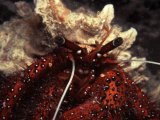Friday, March 27, 2009
Crabs feel and remember pain
 New research published by a Queen's University academic has shown that crabs not only suffer pain but that they retain a memory of it.
New research published by a Queen's University academic has shown that crabs not only suffer pain but that they retain a memory of it.The study, published in the journal Animal Behaviour, looked at the reactions of hermit crabs to small electric shocks. It was was carried out by Professor Bob Elwood and Mirjam Appel from the School of Biological Sciences at Queen's University Belfast.
Professor Elwood, who previously carried out a study showing that prawns endure pain, said his research highlights the need to investigate how crustaceans used in food industries are treated.
Hermit crabs have no shell of their own so inhabit other structures, usually empty mollusc shells. When the crab becomes to large for its current shell, it looks for another. When it finds a likely looking one, it will try it on. If the shell doesn't fit, or is too heavy, the crab returns to its old shell and continues it search. Where there is a large population of hermit crabs and a shortage of shells, the crab will accept a sub-standard home: maybe a cracked or uncomfortable shell. But in good conditions it will be very particular about the new shell it chooses.
During the research wires were attached to shells to deliver the small shocks to the abdomen of the some of the crabs within the shells.
The only crabs to get out of their shells were those which had received shocks, indicating that the experience is unpleasant for them.
Hermit crabs are known to prefer some species of shells to others and it was found that that they were more likely to come out of the shells they least preferred. This shows that central neuronal processing occurs rather than the response merely being a reflex. They traded-off between keeping a good shell and acceptance of the shock.
Crabs that had been shocked but had remained in their shell appeared to remember the experience of the shock because they quickly moved towards the new shell, investigated it briefly and were more likely to change to the new shell compared to those that had not been shocked.
Professor Elwood said: “There has been a long debate about whether crustaceans including crabs, prawns and lobsters feel pain. “We know from previous research that they can detect harmful stimuli and withdraw from the source of the stimuli but that could be a simple reflex without the inner ‘feeling’ of unpleasantness that we associate with pain.
“This research demonstrates that it is not a simple reflex but that crabs trade-off their need for a quality shell with the need to avoid the harmful stimulus.
“Such trade-offs are seen in vertebrates in which the response to pain is controlled with respect to other requirements.
“Humans, for example, may hold on a hot plate that contains food whereas they may drop an empty plate, showing that we take into account differing motivational requirements when responding to pain.
“Trade-offs of this type have not been previously demonstrated in crustaceans. The results are consistent with the idea of pain being experienced by these animals.”
Professor Elwood says that in contrast to mammals, little protection is given to the millions of crustaceans that are used in the fishing and food industries each day. He added "Millions of crustacean are caught or reared in aquaculture for the food industry. There is no protection for these animals (with the possible exception of certain states in Australia) as the presumption is that they cannot experience pain.
Journal Reference:
Robert W. Elwood and Mirjam Appel, Pain experience in hermit crabs?, Animal Behaviour (2009), doi:10.1016/j.anbehav.2009.01.028.
-
What do you think of this news item? Join a discussion.
Labels: marine biology, research, SCUBA News